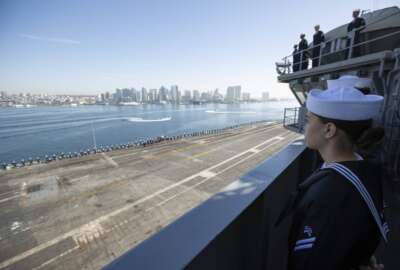Navy project brings promise of cloud to the middle of the ocean
Aboard the U.S.S. Abraham Lincoln, the Navy is figuring out what's possible when is has enormous data pipes that have never before been available to ships.
From virtual desktops to email and collaboration, the Navy has been leaning heavily on cloud services to speed up its digital modernization efforts. But those efforts have come with a big question: Will any of this work aboard ships? It turns out the answer is yes.
In a pilot project, the Navy has shown it’s possible to consistently move several terabytes of data each day between the cloud and thousands of users onboard an aircraft carrier every single day, an advance officials say is a “game changer”
The project is called Flank Speed Edge, an extension of Flank Speed, the Navy’s broader cloud environment. The largest test case has been aboard the U.S.S. Abraham Lincoln, which is currently underway in the Pacific, and represents the first major example of the Navy connecting a vessel at sea with cloud services in a way that’s on par with what sailors get on shore.
Leveraging P-LEO satellites
It’s mostly thanks to the advent of Proliferated Low Earth Orbit (P-LEO) satellite services — massive constellations of small satellites that form mesh networks via optical links with one another in space, and deliver high-bandwidth, low latency communications to users back on Earth.
Cmdr. Kevin White, the combat systems officer aboard the Lincoln, said the initial idea was to install a gigabit’s worth of satellite connectivity aboard the ship and see what the ship’s 5,000 sailors and Marines could do with it. It turns out, quite a lot.
“I’ve seen a tremendous value from from this afloat. All of the staff are using their Flank Speed capabilities to maintain continuity,” he told the Navy CIO’s recent IT conference in Norfolk, Virginia, during a live video demonstration from the Pacific Ocean. “They’re using their NMCI phones to call home over voice over IP, or to call the beach to say, ‘Hey, I need this part rushed to the ship.’ We’re using it across all of our departments and embarked commands for quality-of-work type areas. Everything from our training department — ensuring that all of our readiness in our training cycle is up to date — to our medical department, to our supply department, they’re all reaching out over websites and services to ensure that we have continuity of operations, and ensure that this ship is ready to go when the time comes that we have to turn these services off.”
One thing the Navy has learned from the Lincoln experience is that Flank Speed Edge doesn’t require a huge amount of manpower. It’s taken just three full-time sailors to operate and maintain the new satellite and Wi-Fi infrastructure aboard the carrier.
And in return, it’s also dramatically expanded the kinds of software upgrades and updates that can be performed on other systems on the ship, White said. Traditionally, that’s the kind of work that can only be done at a pier with a physical network connection.
“While we’re out at sea right now, with this P-LEO capability, a cloud connected node and all the right elements in place, we’re able to scale new capabilities as they become available and rapidly deploy them while they’re monitored from the shore side,” he said. “One of the big challenges we have is the cycle of Windows updates and the cycle of patches, and with that high-speed capability, we can have those update services enabled. Onboard, we have 2,000 staff folks, all of which are live at their home commands on Flank Speed. Imagine a future where we are able to migrate that data to an embarkable [laptop], and allow them to interoperate with that data when we have to turn off our connections.”
The approach does have its limitations. Besides the obvious need to sometimes shut down those high-speed data links for operational reasons — leaving the ship with only its onboard tactical cloud nodes — the P-LEO connections, so far, are only authorized for unclassified data.
But White said the on-board infrastructure is designed to be transport agnostic — so that it can use whatever connectivity mechanism is available — from traditional military SATCOM to commercial services like Starlink. It’s also designed to incorporate software defined networking, so that the network capacity available through those data links can be used however the Navy sees fit, and can be reallocated on the fly.
“Right now our logs are showing that we’re able to pass between 3 and 5 terabytes of data per day, which is absolutely massive. And what we’re able to do with software defined networks is scale exactly how that data is used,” he said. “Right now we’re demonstrating pushing applications like air wing maintenance apps that live in the cloud, and all of our pay and personnel apps. And that’s just scratching the surface.”
Other applications ashore
The Navy is using similar concepts in other places of the world that may not be as hard to connect as ships, but still have tended to have communications challenges.
The service’s 5th Fleet is serving as a pilot site for a shore-based implementation of Flank Speed Edge. At the command’s headquarters in Bahrain, staff have recently started using Flank Speed services, including Nautilus Virtual Desktop.
Lt. Cmdr. Tricia Nguyen, a staff member at Naval Computer and Telecommunications Station Bahrain said so far, the Flank Speed approach has turned out to be more seamless and resilient than the Navy’s traditional overseas networks.
“It is a vast improvement compared to the previous assets and legacy architecture,” she said. “The user interface is quick and responsive — applications are able to be opened natively instead of using browser-based workarounds. Simple things matter here: The file sync is seamless. I don’t have to log in multiple times like I used to; now I just boot up and my files are there. And back in March, there was a Teams service outage, which I understand was worldwide. However, here in Bahrain, we did not experience an outage at all. That was because of the architecture: We have a primary and secondary means of transport that are terrestrial based, and a tertiary that’s commercial satellite. We had an automatic failover and it was completely seamless and transparent to our end users. I didn’t even know about it until after the fact.”
Bob Stephenson, the chief information officer for U.S. Pacific Fleet, said some of what the Navy has learned through the pilots — especially their uses of secure WiFi — may also be applicable to communications on installations, such as his command’s headquarters at Pearl Harbor.
“We’ve been using the same technology in our buildings that we’ve used since the late 90s. As our staff changes and grows, it’s very difficult for us with a wired infrastructure to bring more people into the building, or rearrange the office,” he said. “So we’re doing a pilot now sponsored by PEO Digital where we’ve gone to wireless in the buildings. We still have to use fiber for our secret networks, and we’d like to change that, but this is going to give us an enormous capability to modernize our buildings like we’re modernizing our ships.”
Copyright © 2025 Federal News Network. All rights reserved. This website is not intended for users located within the European Economic Area.
Jared Serbu is deputy editor of Federal News Network and reports on the Defense Department’s contracting, legislative, workforce and IT issues.
Follow @jserbuWFED






